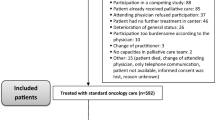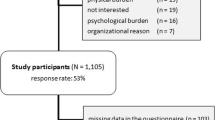Abstract
Background
Mood disorders are among the most distressing psychiatric conditions experienced by patients with advanced cancer; however, studies have not shown a direct association of physical symptoms with depression and anxiety.
Purpose
The purpose of this study is to determine the relationship between the frequency and intensity of patients’ physical symptoms and their expressions of depression and anxiety.
Patients and methods
We retrospectively reviewed the records of 216 patients who had participated in three previous clinical trials conducted by our group. We assessed patients’ demographic data using descriptive statistics. We analyzed physical symptom frequency and intensity using the Edmonton Symptom Assessment System (ESAS) and anxiety and depression using the respective subscales of the Hospital Anxiety and Depression Scale (HADS-A and HADS-D).
Results
Sixty-two percent were male; the median age was 59 years (range 20–91 years). Seventy nine (37%) of the patients had depressive mood (HADS-D ≥ 8), and 94 (44%) had anxiety (HADS-A ≥ 8). Patients with depressive mood expressed higher frequency of drowsiness (68/78, 64%; p = 0.0002), nausea (52/79, 66%; p = 0.0003), pain (74/79, 94%; p = 0.0101), dyspnea (68/79, 86%; p = 0.0196), worse appetite (72/79, 91%; p = 0.0051), and worse well-being (78/79, 99%; p = 0.0014) and expressed higher intensity of symptoms (ESAS ≥ 1) [median (Q1–Q3)] including drowsiness [4 (3–7), p = 0.0174], fatigue [7 (5–8), p < 0.0001], and worse well-being [6 (5–7), p < 0.0001]. Patients with anxiety expressed higher frequency of nausea (59/94, 57%; p = 0.0006), pain (88/94, 89%; p = 0.0031), and dyspnea (84/94, 96%, p = 0.0002) and expressed a higher intensity of pain [6 (3–8), p = 0.0082], fatigue [6 (5–8), p = 0.0011], worse appetite [6 (4–8), p = 0.005], and worse well-being [5 (3–7), p = 0.0007]. Spearman’s correlation showed a significant association between HADS-A and HADS-D and other symptoms in the ESAS. Spearman’s correlations of HADS with ESAS-Anxiety and ESAS-Depression were 0.56 and 0.39, respectively (p < 0.001).
Conclusion
Expression of physical symptoms may vary in frequency and intensity among advanced cancer patients with anxiety and depression. Patients expressing high frequency and intensity of physical symptoms should be screened for mood disorders in order to provide treatment for these conditions. More research is needed.
Similar content being viewed by others
References
Andrews B, Hejdenberg J, Wilding J (2006) Student anxiety and depression: comparison of questionnaire and interview assessments. J Affect Disord 95:29–34. doi:10.1016/j.jad.2006.05.003
Aragones E, Labd A, Piñol J, Lucena C, Alonso Y (2005) Somatized depression in primary care attenders. J Psychosom Res 58:145–151. doi:10.1016/j.jpsychores.2004.07.010
Asbury FD, Madlensky L, Raich P et al (2003) Antidepressant prescribing in community cancer care. Support Care Cancer 11:278–285
Block S (2000) Assessing and managing depression in the terminally ill patient. Ann Intern Med 32:209–218
Bruera E, Kuehn N, Miller M, Selmser P, Macmillan K (1991) The Edmonton symptom assessment system (ESAS): a simple method for the assessment of palliative care patients. J Palliat Care 7:6–9
Chang VT, Hwang SS, Feuerman M (2000) Validation of the Edmonton symptom assessment scale. Cancer 88:2164–2171. doi:10.1002/(SICI)1097-0142(20000501)88:9<2164::AID-CNCR24>3.0.CO;2-5
Chen ML, Chang HK (2004) Physical symptom profiles of depressed and nondepressed patients with cancer. Palliat Med 18:712–718. doi:10.1191/0269216304pm950oa
Dantzer R (2005) Somatization: A psychoneuroimmune perspective. Psychoneuroendocrinology 30:947–952. doi:10.1016/j.psyneuen.2005.03.011
Drayer R, Mulsant B, Lenze E, Rollman B (2005) Somatic symptoms of depression in elderly patients with medical comorbidities. Int J Geriatr Psychiatry 20:973–982. doi:10.1002/gps.1389
Grassi L, Indelli M, Marzola M et al (1996) Depressive symptoms and quality of life in home-care-assisted cancer patients. J Pain Symptom Manage 12:300–307. doi:10.1016/S0885-3924(96)00181-9
Holland JC, Jacobsen PB, Riba MB (2001) NCCN distress management. Cancer Control 8(6):88–93
Hotopf M, Chidgey J, Addington-Hall J, Lan Ly K (2002) Depression in advanced disease: a systematic review. Part 1: prevalence and case finding. Palliat Med 16:81–97. doi:10.1191/02169216302pm507oa
Katon W, Lin E, Kroenke K (2007) The association of depression and anxiety with medical symptom burden in patients with chronic medical illness. Gen Hosp Psychiatry 29:147–155. doi:10.1016/j.genhosppsych.2006.11.005
Komaroff AL (2001) Symptoms: in the head or in the brain? Ann Intern Med 134:783–785
Kurtz M, Kurtz J, Stommel M, Given C, Given B (2001) Physical functioning and depression among older persons with cancer. Cancer Pract 9:11–18. doi:10.1046/j.1523-5394.2001.91004.x
Lloyd-Williams M, Friedman T, Rudd N (1999) A survey of antidepressant prescribing in the terminally ill. Palliat Med 13:243–248. doi:10.1191/026921699676753309
Lloyd-Williams M, Dennis M, Taylor F (2004) A prospective study to determine the association between physical symptoms and depression in patients with advanced cancer. Palliat Med 18:558–563. doi:10.1191/0269216304pm923oa
Love A, Grabasch B, Clarke D, Bloch S, Kissane D (2004) Screening for depression in women with metastatic breast cancer: a comparison of the beck depression inventory short form and the hospital anxiety and depression scale. Aust N Z J Psychiatry 38:526–531. doi:10.1111/j.1440-1614.2004.01385.x
Lowe B, Spitzed RL, Grafe K, Kroenke K et al (2004) Comparative validity of three screening questionnaires for DSM-IV depressive disorders and physicians’ diagnoses. J Affect Disord 78:131–140. doi:10.1016/S0165-0327(02)00237-9
Maguire P (2000) The use of antidepressants in patients with advanced cancer. Support Care Cancer 8:265–267. doi:10.1007/s005200000170
Massie MJ (2000) Prevalence of depression in patients with cancer. J Natl Cancer Inst Monogr 32:57–71
Massie MJ, Gagnon P, Holland JC (1994) Depression and suicide in patients with cancer. J Pain Symptom Manage 9:325–340. doi:10.1016/0885-3924(94)90192-9
Ng K, von Gunten C (1998) Symptoms and attitudes of 100 consecutive patients admitted to an acute hospice/palliative care unit. J Pain Symptom Manage 16:307–316. doi:10.1016/S0885-3924(98)00097-9
Olsson I, Mylketun Am Dahl Alv A (2005) The hospital anxiety and depression rating scale: a cross-sectional study of psychometrics and case finding abilities in general practice. BMC Psychiatry 5:46. doi:10.1186/1471-244X-5-46
Pascoe S, Edelman S, Kidman A (2000) Prevalence of psychological distress and the use of support services by cancer patients at Sydney hospitals. Aust N Z J Psychiatry 34:785–791. doi:10.1046/j.1440-1614.2000.00817.x
Payne SA (1992) A study of quality of life in cancer patients receiving palliative chemotherapy. Soc Sci Med 35:1505–1509. doi:10.1016/0277-9536(92)90053-S
Perry MC (ed) (2000) An algorithm for rapid assessment and referral of distressed patients. American Society of Clinical Oncology, Alexandria
Porzio G, Ricevuto E, Aielli F et al (2005) The supportive care task force at the university of L’Aquila: 2-years experience. Support Care Cancer 13:351–355. doi:10.1007/s00520-004-0772-5
Radbruch L, Nauck F, Ostgathe C et al (2003) What are the problems in palliative care? Results from a representative survey. Support Care Cancer 11:442–415. doi:10.1007/s00520-003-0472-6
Rajagopal A, Bruera ED (2003) Improvement in sexual function after reduction of chronic high-dose opioid medication in a cancer survivor. Pain Med 4:379–383. doi:10.1111/j.1526-4637.2003.03041.x
Rajagopal A, Vassilopoulou-Sellin R, Palmer JL, Kaur G, Bruera E (2004) Symptomatic hypogonadism in male survivors of cancer with chronic exposure to opioids. Cancer 100:851–858. doi:10.1002/cncr.20028
Reddy S, Elsayem A, Palmer L, Kaur G, Zhang T, Bruera E (2005) The characteristics and correlates of dyspnea (D) in advanced cancer patients. J Clin Oncol 23:8019, ASCO Annual Meeting Proceedings [Abstract #8019 (poster discussion)]
Rees E, Hardy J, Ling J, Broadley K, A’Hern R (1998) The use of the Edmonton Symptom Assessment Scale (ESAS) within a palliative care unit in the UK. Palliat Med 15:213–214
Reuben D, Mor V, Hiris J (1998) Clinical symptoms and length of survival in patients with terminal cancer. Arch Intern Med 148:1586–1591. doi:10.1001/archinte.148.7.1586
Roy-Byrne PP, Davidson KW, Kessler R et al (2008) Anxiety disorders and comorbid medical illness. Gen Hosp Psychiatry 30:208–225. doi:10.1016/j.genhosppsych.2007.12.006
Sharpe M, Strong V, Allen K et al (2004) Major depression in outpatients attending a regional cancer center: screening, prevalence and unmet treatment needs. Br J Cancer 90:314–320. doi:10.1038/sj.bjc.6601578
Smith EM, Gomm SA, Dickens CM (2003) Assessing the independent contribution to quality of life from anxiety and depression in patients with advanced cancer. Palliat Med 17:509–513. doi:10.1191/0269216303pm781oa
Stromgren AS, Groenvold M, Peterson MA et al (2004) Pain characteristics and treatment outcome for advanced cancer patients during the first week of specialized palliative care. J Pain Symptom Manage 27:104–113. doi:10.1016/j.jpainsymman.2003.06.011
Teunissen SCCM, de Graeff A, Voest EE, de Haes JCJM (2007) Are anxiety and depressed mood related to physical symptom burden? A study in hospitalized advanced cancer patients. Palliat Med 21:341–346. doi:10.1177/0269216307079067
Teunissen SCCM, Wesker W, Kruitwagen C et al (2007) Symptom prevalence in patients with incurable cancer: a systematic review. J Pain Symptom Manage 34:94–103. doi:10.1016/j.jpainsymman.2006.10.015
Vignaroli E, Pace E, Willey J et al (2006) The Edmonton symptom assessment as a screening tool for depression and anxiety. J Palliat Med 9:296–303. doi:10.1089/jpm.2006.9.296
Wilson KG, Chochinov HM, Skirko MG et al (2007) Depression and anxiety disorders in palliative cancer care. J Pain Symptom Manage 33:118–129. doi:10.1016/j.jpainsymman.2006.07.016
Acknowledgement
This research study was presented as invited lecture at the Supportive Care in Cancer MASCC/ISOO 2008 International Symposium in Houston, Texas on June 26–28, 2008.
Author information
Authors and Affiliations
Corresponding author
Rights and permissions
About this article
Cite this article
Delgado-Guay, M., Parsons, H.A., Li, Z. et al. Symptom distress in advanced cancer patients with anxiety and depression in the palliative care setting. Support Care Cancer 17, 573–579 (2009). https://doi.org/10.1007/s00520-008-0529-7
Received:
Accepted:
Published:
Issue Date:
DOI: https://doi.org/10.1007/s00520-008-0529-7




